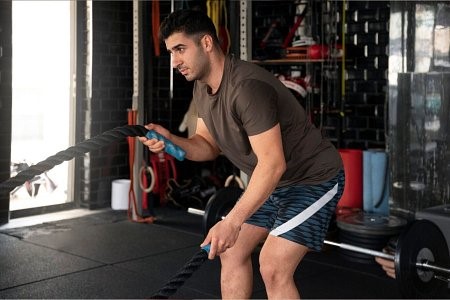As athletes, we push our bodies to the limit, and sometimes, injuries happen. Whether it’s a nagging muscle strain or a more serious setback, getting back to peak performance as quickly as possible is paramount. While physiotherapy plays a crucial role in the rehabilitation process, there’s another powerful tool in your arsenal: nutrition.
The food you choose significantly impacts your body’s ability to heal and rebuild itself. In this blog, we’ll delve into the fascinating connection between food and recovery, exploring how optimizing your diet can fuel a faster and more effective comeback.

Table of Contents
Understanding the Impact of Injury
Imagine your body as a finely tuned machine. When an injury occurs, it’s like a wrench thrown into the gears. Inflammation sets in, tissues break down, and your body goes into overdrive to repair the damage. This process requires a significant amount of energy and resources.
Think of it like a construction project. To rebuild a structure, you need bricks, mortar, tools, and the workers. Similarly, your body needs the right building blocks – macronutrients and micronutrients – to repair damaged tissues and restore optimal function.
The Pillars of Muscle Repair and Recovery
Protein: The undisputed champion of muscle repair is protein. It serves as the building block for muscle tissue, and during rehabilitation, your body requires a higher intake of protein compared to normal training periods. Aim for 1.2-2 grams of protein per kilogram of body weight daily, distributed throughout your meals and snacks. Consider including protein sources like chicken, fish, lean meats, eggs, dairy products, and legumes in your diet.
Carbohydrates: Don’t underestimate the power of carbs! They provide readily available energy to fuel your body’s healing processes. Choose complex carbohydrates like whole grains, brown rice, sweet potatoes, and fruits to ensure sustained energy levels throughout the day.
Fats: Healthy fats are not the enemy! They play a crucial role in reducing inflammation, which can hinder healing. Include sources like avocados, nuts, seeds, and olive oil in your diet.

The Essential Toolkit for Healing
Micronutrients, like vitamins and minerals, act as the tools and workers in our construction analogy. They work behind the scenes, facilitating various functions necessary for healing. Here are some key players:
- Vitamin C: This powerful antioxidant promotes collagen synthesis, a vital component of connective tissues. Include citrus fruits, berries, bell peppers, and broccoli in your diet.
- Zinc: This mineral supports immune function and tissue repair. Consider incorporating seafood, lean meats, pumpkin seeds, and chickpeas into your meals.
- Vitamin D: Essential for bone health, Vitamin D also plays a role in muscle function and recovery. Sunlight exposure is a great source, but consider food sources like fatty fish and fortified dairy products as well.

Tailoring Your Diet for Specific Injuries
While the principles discussed above hold true for most injuries, some require specific nutritional considerations:
- Bone Fractures: For optimal bone healing, prioritize calcium-rich foods like dairy products, leafy greens, and fortified cereals. Vitamin D intake is also crucial.
- Muscle Injuries: Here, focus on providing the building blocks for muscle repair. Increase protein intake and include anti-inflammatory foods like fruits and vegetables rich in antioxidants.
- Tendonitis: For tendon healing, consider incorporating foods rich in omega-3 fatty acids (found in fatty fish) and antioxidants to reduce inflammation.
Food First, Supplements Second
A balanced and varied diet should be your primary source of nutrients for recovery. Supplements can play a supportive role, but they should never be a substitute for a healthy diet. Consult a registered dietitian or a sports nutritionist for personalized advice on incorporating supplements into your rehabilitation plan.

The Winning Formula: Combining Physiotherapy with Nutritional Guidance
While proper nutrition fuels your recovery from the inside out, physiotherapy helps to address the injury itself. The combination of these two elements creates a winning formula for a faster, more complete comeback. Consider working with a team of professionals who can create a customized plan that combines effective physiotherapy techniques with personalized nutritional guidance. This holistic approach will help you achieve optimal recovery and get back to dominating your sport.
Many sports physiotherapy clinics, like AppliedMotion Physiotherapy in Leederville, WA offer comprehensive rehabilitation programs that integrate physiotherapy with nutritional advice. Their team of experienced clinicians can work with you to develop a personalized plan that addresses your specific injuries and nutritional needs, helping you get back to peak performance as quickly as possible.
Lifestyle Habits for Enhanced Recovery
While optimizing your diet plays a vital role in recovery, a holistic approach is key. Here are some additional lifestyle habits that can accelerate your comeback:
- Prioritize Sleep: During sleep, your body goes into repair mode, releasing growth hormones and rebuilding damaged tissues. Aim for 7-8 hours of quality sleep each night. Create a relaxing bedtime routine and establish a consistent sleep schedule.
- Manage Stress: Constant stress can hinder the healing process. Find healthy ways to manage stress, such as meditation, yoga, or spending time in nature.
- Hydration is Key: Water is essential for transporting nutrients throughout the body and flushing out waste products. Aim to drink enough water throughout the day, especially after workouts and physiotherapy sessions.
- Listen to Your Body: Don’t push yourself too hard too soon. Pay attention to your body’s signals and gradually increase your training intensity as your injury heals.
Working with a Sports Nutritionist for Personalised Guidance
A registered sports nutritionist can provide invaluable support throughout your recovery journey. They can assess your individual needs, taking into account your injury, training program, and dietary preferences. They can then create a personalized meal plan to optimize your nutrient intake and support your recovery goals.
A sports nutritionist can also help you with:
- Understanding your calorie needs: During rehabilitation, your calorie requirements may increase to support the healing process. A sports nutritionist can help you determine the right amount of calories to consume for optimal recovery.
- Timing your meals and snacks: Strategic timing of meals and snacks can further enhance the benefits of your diet. Your sports nutritionist can advise you on the best times to consume protein, carbohydrates, and other nutrients to maximize their impact on recovery.
- Developing healthy eating habits: Recovery is a great opportunity to establish healthy eating habits that will benefit you not only during rehabilitation, but also throughout your athletic career. A sports nutritionist can help you make sustainable changes to your diet for long-term success.

Fueling Your Road to Victory
Remember, recovery is an investment in your athletic future. By prioritizing a balanced diet, incorporating healthy lifestyle habits, and potentially working with a sports nutritionist, you can create a winning formula for a faster and more complete comeback. This will allow you to get back to doing what you love – pushing your limits and achieving peak performance in your sport.
Don’t let an injury sideline you for longer than necessary. Consider contacting a clinic like AppliedMotion Physiotherapy and Podiatry in Leederville. Their team of experienced physiotherapists and their network of sports nutritionists can work together to develop a comprehensive rehabilitation program that addresses both your physical and nutritional needs, helping you get back on the field, court, or track stronger than ever.

